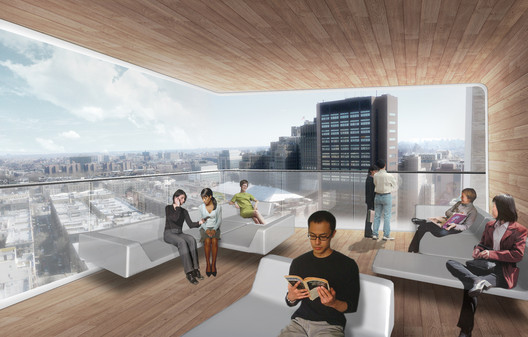
Columbia University has been at the forefront of medical education for more than two centuries, as it was the first medical school in the United States to award the M.D. degree in 1770. Now, the Columbia University Medical Center (CUMC) has announced plans for a new, state-of-the-art medical and graduate education building that reflects how they believe medicine is and should be taught, learned and practiced in the 21st century.
Located on the CUMC campus in the Washington Heights community of Northern Manhattan, the 14-story facility will aim to achieve LEED Gold certification and incorporate technologically advanced classrooms, collaboration spaces, and a modern simulation center. The design is led by Diller Scofidio + Renfro, in collaboration with Gensler as executive architect.
Continue after the break for more details!
“The new Medical and Graduate Education Building will be the social and academic anchor of the CUMC campus,” said Elizabeth Diller, principal-in-charge of the project Diller Scofidio + Renfro. “Spaces for education and socializing are intertwined to encourage new forms of collaborative learning among students and faculty.”

The facility will create a community of students and facility from all four CUMC schools (P&S, Nursing, Dental Medicine and the Mailman School of Public Health) as well as the biomedical departments of the Graduate School of Arts and Sciences. The integration of mixed curriculum and an emphasis on team-based learning is reflected throughout the building.
The design weaves together areas for study and other activities that are important in a 21st-century university building. It features technology-enabled classrooms; a state-of-the-art medical simulation center that will replicate clinics, operating rooms and other real world medical environments; innovative learning facilities for both collaboration and quiet study; an auditorium and event areas with integrated technology; centralized student support services; student lounges and cafés; and multiple purpose outdoor spaces, including a terrace with views of the Hudson River.

The “Study Cascade” is the principle design strategy of the building – a network of social and study spaces distributed across oversized landings along an intricate 14-story stair. The Study Cascade creates a single interconnected space the height of the building, stretching from the ground floor lobby to the top of the building, and conducive to collaborative, team-based learning and teaching. The “Study Cascade” interiors are complemented by a distributed network of south-facing outdoor “rooms” and terraces that are clad with cement panels and wood. While the “Study Cascade” provides an organizational strategy for the building’s interior, it is also an urban gesture that, with its glass façade, aims to become a visual landmark at the northern limit of Columbia University’s medical campus. The northern face of the building houses space for classrooms, clinical simulation and administration and support.

The landmark building is expect to break ground in early 2013 and pierce the Manhattan skyline upon completion mid-2017.

“The new building provides upgraded education facilities that reflect the eminence of one of the top medical schools in the world. Both the building and the newly created green space that will surround it will also revitalize our campus in ways that will benefit both our medical center and the entire community,” said Lee Goldman, M.D., dean of the faculties of health sciences and medicine at CUMC and executive vice president for health and biomedical sciences at Columbia University.











